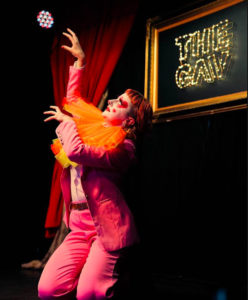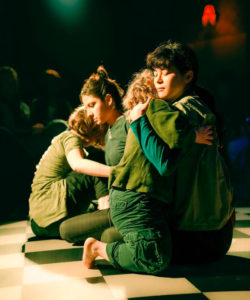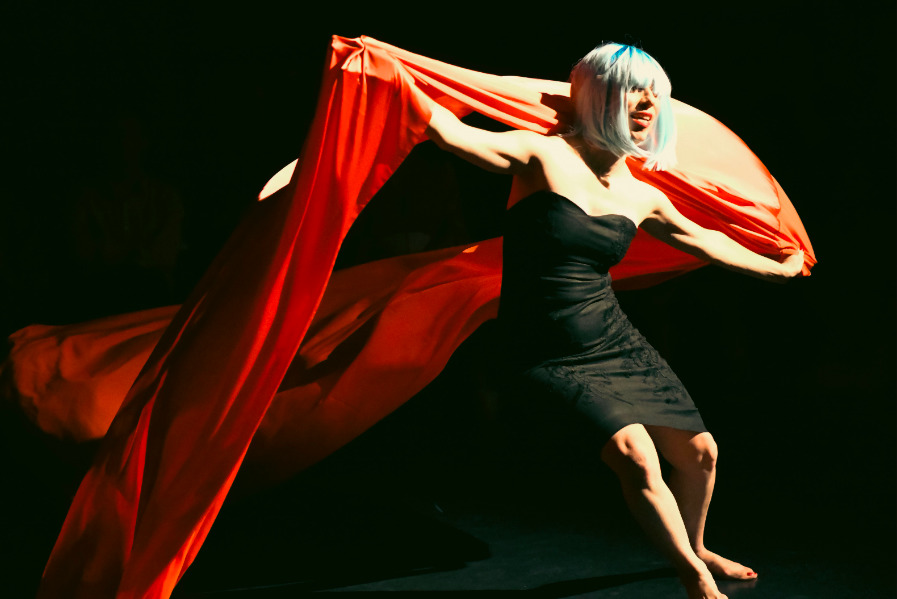Words by Stella Rousham.
Inspired by her undergraduate studies in improvisation, Mind the Gap was set up by Théïa Maldoom nearly four years ago as an open, supportive, mixed bill performance platform. Showcasing a range of improvised acts – including dance, comedy and even drawing – the platform runs roughly every 2-9 months in small theatre venues across London.
Following the most recent iteration of the platform, hosted at Longfield Hall in early June, I caught up with Théïa over Zoom. Through our discussion, I gleaned insight into the unique role that this platform, and improvisation more broadly, plays in supporting artistic development.
As an early-career freelancer, for Théïa, having a free, non-judgemental space to practice, play and perform has been invaluable for boosting her self-esteem and refining her performance technique whilst also helping build a network of care and collaboration. The overall result; a platform that feeds artists on an individual and collective level, celebrating the pursuit of trying out new ideas.
SR: The first question I have is: can you explain what Mind the Gap is and the ethos behind it?
TM: The tagline for Mind the Gap is a mixed bill of improvised performances. What is it? I guess it started from quite a clear feeling from me of an interest in performing improvisation and learning about how others approach improvisation. If improvisation is the right word at all…other terms like spontaneous composition or freestyling, might fit better. The platform is a research into all of those things. Something to do with creating in the moment and all the different ways that people might approach this.
When I had graduated from uni and was freelancing, platforms like Mind the Gap were having a really great impact for me. I would look forward to them in my diary, especially if I didn’t have much work. These platforms would be really great for my self-esteem and practice, to hold onto and to express this thing of being a dancer or performer. I was also just aware that there weren’t that many small platforms where people could show their work and I wanted there to be more.
SR: That sounds great. And is it just yourself who set it up? Is there a team behind it?
TM: It was initiated by me and I do the majority of the legwork, but there’s loads of wonderful people around me that I bounce ideas around with and who help on the night as well. It’s mostly me, which is part of the reason why I have a kind of ethos of making it as low work as possible. What’s sustainable and enjoyable for me? Prioritising what feels good, so it kind of fulfils and feeds me too.
For the latest platform, I collaborated with Scilla Rajalin because I was a bit …. not bored, but I just wanted fresh perspectives on the night. I really enjoyed it, not just being me thinking about it. I think in the future I’ll continue this structure of collaborating with someone to co-curate it.
SR: Absolutely, it’s so different collaborating on a project, it kind of takes you out of your own head when you’re creating in this way.
TM: And it really added a lot of fresh perspectives for me, as well as a charge – a trust and energy. I really trusted Scilla’s vision.
SR: What drew you to set up a platform for improvised performance specifically? Was it something that you had done during your studies that you wanted to explore more? Had you worked with an artist doing improvisation?
TM: Whilst studying at London Contemporary Dance School, I had found improv to be a really great way of expressing myself and creatively putting stuff out there that I felt really connected to and proud of. In my third year of uni, around 2019/2020, I started practising improvisation with one of my lecturers at the time, Seke Chimutengwende.
Practising together built a really rich, supportive dialogue between us, which we have continued to this day. Our collaboration around improv started during lockdown and really carried me through the pandemic as a dancer – it was my main source of engagement with performance for quite a while.
For me, this form of improvising – using movement, voice, character and speech is a great undercurrent to everything that underpins being being body-articulate.
SR: Improvisation also tests your skills and practice around performing in such a different way to learning set repertoire because of the unpredictability. Can you maintain your performative qualities without the structure of a set routine or choreography?
TM: Yeah, there’s an aliveness to improvisation that I think can inform all the other stuff – set choreography and everything. It’s really stripped back. If you start from nothing, how do you engage interest in and generate a performance from just the energies that are around?

Performer (Jay Yule) with heart shaped makeup around eyes and big clown ruffle: Becca Hunt.

4 performers (Bun Kobayashi, Annie Edwards, Alejandra Gissler and Theia Maldoom), front two in an embrace:
Becca Hunt.

SR: In terms of improvisation, you mentioned you use speech and movement. Who are the artists that perform at Mind the Gap and what is your selection process?
TM: My initial idea for the night was to be multidisciplinary – be as broad as possible with the range of acts involved in the show, in order to study improv, see how different mediums approach improv and grasp different understandings of what the word actually means. To start off with, I would try to have a dance act, a music act, a theatre/live art act, a comedy act – a real range. From there, I would also try get a range of different genres or styles within those disciplines as well.
In the most recent platform with Scilla, it definitely had a more dance-oriented undercurrent. In the past we’ve had someone who got the audience involved in doing live improvised drawing. In this act, I performed as the muse for the audience to draw live from. My friend Ioana, led the audience through a drawing and mark making workshop. She handed out great big scrolls of paper, pens and chalks, then she transformed it into a zine at the end. She chopped up the paper, folded it up so audience members could take away a zine of their drawings as an offering. We’ve also had drag performers, such as Jay Yule who did a wonderful performance.
SR: Do you reach out to artists after finding their work or do artists send their work in to you?
TM: A combination. Quite often it will be people that I already know. Apart from the comedy acts – I had one friend that always kept trying to get involved with the show, but she could never do it, so she would put me in contact with other comedy groups. That felt the most like “ticking a box”, it wasn’t really rooted in me knowing the artists or being connected to them. Whereas with the other acts, I have either known them for a while or was interested in them through Instagram.
I did do one open call out and I got like 50 responses. I was like ‘Whoa’. People are really interested in this. That was really revealing. I think part of getting someone else in – like working with Scilla – was that I didn’t want the selection to just be on me. I’m aware that I have biases towards people that I know, so working with Scilla was a way to spread the net wider.
SR: Call outs are really revealing and it’s always amazing to see how far your platform or organisation reaches. You realise just how many people are out there looking for similar opportunities. What can an audience expect from a typical Mind the Gap showcase?
TM:I don’t know now, because it’s changing shape, because I invite collaborators to curate it, I don’t know what it will look like in the future.
Something that I’ve really enjoyed doing in the past is gathering three words from members of the audience, which are all up on the Instagram. For example: ‘different’, ‘fun’, ‘exciting’, ‘insanely hilarious’, ‘awe-inspiring’, ‘delirious’, ‘hilarious’, ‘precarious’, ‘absurdity’, ‘prepared to be unprepared’, ‘refreshing’, ‘brave’, ‘warm’. I like the idea of variety. I like the idea that performers can just try an idea out and maybe it’s not perfect or refined, but they have a space to do that with an audience. I like the idea that it’s an environment of support. I try to encourage a sense of openness and caring within the room – a celebration of people doing something.
I think it’s really shifting and evolving thing, so I don’t know what audiences can expect.
SR: That’s part of the nature of improv, isn’t it? You’ve got to let go of expectations and see what unfolds? And name Mind the Gap? Is there a meaning behind it? I think it’s a really great name.
TM: I was searching for a name and I was flicking through this book – Improvisation on the Edge by Ruth Zaporah – and there was something about minding the space in between things and that being the space of opportunity and interest. What’s in the gap, what can we dive into and become? I think it’s also funny that it references the tube.
SR: I think that’s super interesting thinking about how improvisation is rooted in allowing yourself to sit in that space of uncertainty.
What are your hopes for the future of Mind the Gap? Where do you see it going?
TM: I’m really interested in it carrying on in a sustainable way. I don’t know how often I will do it. It’s been a bit varied and sporadic. At the most recent night, we had a jam at the end with some of the musicians who performed – we opened that up to the audiences which was wonderful. Maybe we will continue the jam or maybe there’ll be some other form of expression or involvement for the audience as well.
I’m just really excited to see who’s out there, what’s going on, continue the conversation. Part of it is just enjoying putting acts together, putting on a show and being excited at how acts will perform alongside one another. Gathering people in a celebration of improv, art, community, trying things. In the future, I see continuation and I wanna say growth, but that sounds kind of cringey, so I am going to say, meeting new people.
SR: Is there anything else you want to add?
TM: I guess I want encourage people to be in contact if they are interested in being involved! I am very open. I think that’s all.
Interested in watching and/or performing in the next Mind the Gap platform? Make sure to follow and get in touch with Théïa here: https://theiamaldoom.co.uk/improvisation
